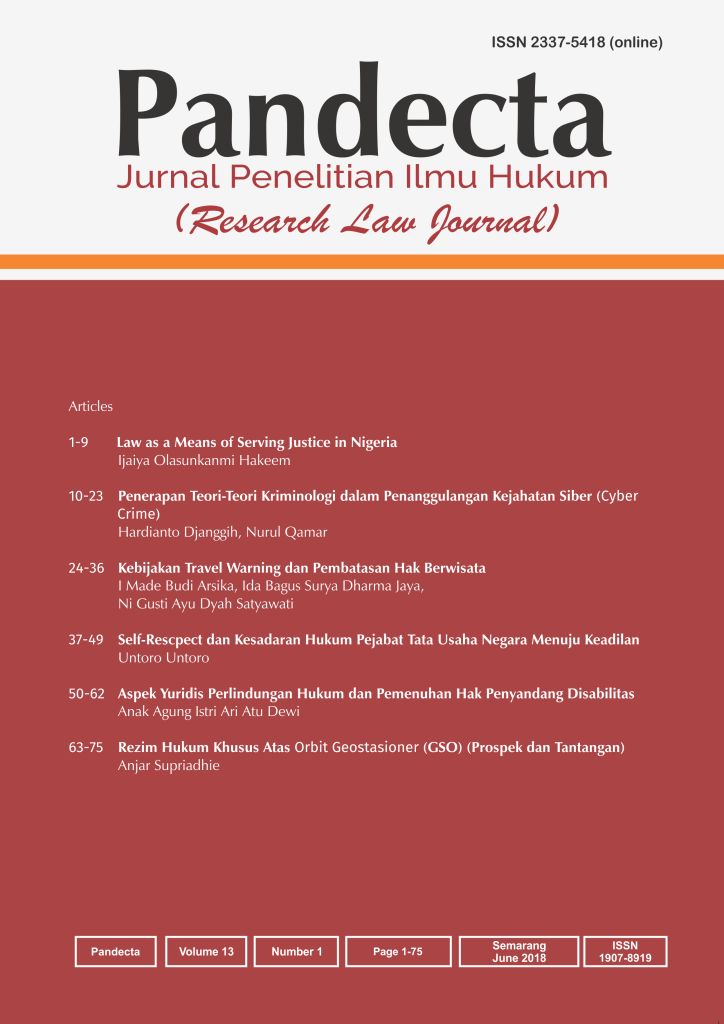Implementasi Model Zonasi Penataan Pedagang Kaki Lima di Kota Bandung
(1) Fakultas Hukum Universitas Negeri Semarang
Abstract
The rise of street vendors who crowded city environments with hold merchandise diruas roads and other public spaces are found to be in accordance with the city planning system. Thus the state of Bandung City Government urged to organize the street vendors to establish a Regional Regulation No. 4 of 2011 Bandung About Management and Development street vendors. Issues examined in this study is whether the model zonanisasi arrangement of street vendors in the city, bedampak positively to kejesahteraan PKL. and what are the barriers faced by local government in the city of Bandung zonanisasi structuring models of street vendors in the city. Results and discussion of this study is a model in structuring PKL zonanisasi very positive impact on the welfare of street vendors. Then there are two factors barriers faced by local government, especially municipal police duo in the arrangement of street vendors ie internal factors and external factors Bandung municipal government should be able to increase the re-arrangement of existing street vendors throughout the city of Bandung. Then the need for local government to provide facilities and infrastructure more adequate and continues to provide socialization to all street vendors in the city of Bandung on regulation No. 4 of 2011 on the structuring and formation of street vendors.
Keywords
Full Text:
PDFReferences
Abidin, Kusno, Ruang, Kekuasaan dan Identitas Dalam Konteks Urban di Indonesia: Pendekatan Historikal, dalam Berita LBH Jakarta, Nomor: 11 / Oktober / 2006.
Alisjahbana. 2006. Marginalisasi Sektor Informal PERKOTAAN. ITS Press: Surabaya
Effendi, Tadjudin, Noer. Kesempatan Kerja Informal di Daerah Perkotaan Indonesia (Analisa Pertumbuhan dan Peranannya). Majalah Geografi Indonesia I: Fakultas Geografi UGM, Yogyakarta
Fatnawati, Nur. 2013. Kerangka Hukum dan Kebijakan Pengelolaan Pedagang Kaki Lima, Pandecta: Research Law Journal, Vol. 8 No. 2 Thaun 2013, http://journal.unnes.ac.id/nju/index.php/pandecta/article/view/2681
Handoyo, Eko. 2012. Eksistensi Pedagang Kaki Lima. Salatiga: Tisara grafika.
Herlianto.1986. Pedagang Kaki Lima. Dalam
http://Mujibsite.Wordpers.com/2011/12/22, diakses tanggal 02/04/2015
Marzuki, Peter Mahmud. 2005. Penelitian Hukum. Jakarta : Kencana.
Mokoginta, Lukman . 1999. Jakarta Untuk Rakyat. Jakarta : Pustaka Sinar Harapan.
Moleong, Lexy J. 2009. Metedologi Penelitian Kualitatif. Bandung : PT. Remaja Rosdakarya.
Mulyanto.2007.Pedagang Kaki Lima. Dalam http://www.Goegle.com/PKL, diakses pada tanggal 02/04/2015, 19.40 WIB.
Person, Wayne. 2006. Public Policy: Pengantar Teori dan Praktik. Edis Pertama. Cetakan Ketiga. Dialihbahasakan oleh Tri Wibowo Budi Santoso. Jakarta: Kencana.
Soekanto, Soerjono. 1982. Pengantar Penelitian Hukum. Jakarta : UI-Press.
Soemitro, Ronny Hanitijo. 1994. Metodologi Penelitian Hukum dan Jurimentri. Jakarta : Ghalia Indonesia.
Sunggono, Bambang. 2013 Metodologi Penelitian Hukum. Jakarta : PT RajaGrafindo Persada.
Widodo. 2001. Implementasi Kebijakan. Bandung : CV Pustaka Pelajar.
Peraturan perundang-undangan :
Peraturan Menteri Dalam Negeri Nomor 41 Tahun 2012 Tentang Penataan dan Pemberdayaan Pedagang Kaki Lima
Peraturan Daerah Kota Bandung Nomor 4 Tahun 2011 Tentang Penataan dan Pembinaan Pedagang Kaki Lima
Peraturan Walikota Nomor 888 Tahun 2012 Tentang Petunjuk Pelaksanaan Peraturan Daerah Kota Bandung Nomor 4 Tahun 2011 Tentang Penataan dan Pembinaan PKL di Kota Bandung
Refbacks
- There are currently no refbacks.


